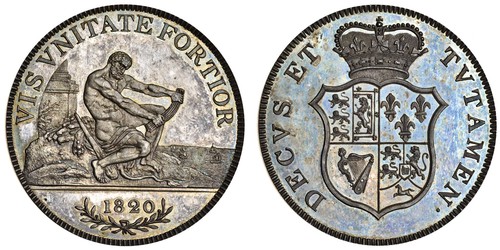
Auction: 15031 - The Slaney Collection of English Coins - Part 2
Lot: 524
George III (1760-1820), pattern Crown, 1820, 26.90g, by J P Droz, vis vnitate fortior, Hercules seated, attempting to break a bundle of sticks over his knee, club and lion's skin beside him, shipping in the distance, date above laurel branch in exergue, toothed border both sides, rev. inverted die axis, decvs et tvtamen., crowned shield, edge plain (ESC 243 - R5; L&S 211; Peck p.216), sharp and uncirculated, lustrous with light old grey toning, extremely rare in silver
provenance
Capt. H E G Paget, Glendining, 25-27 September 1946, lot 435, 'in brilliant state and very rare in silver', £60
Webb collection, purchased privately by Baldwin
The Swiss coin-engraver and medallist Jean-Pierre Droz (1746-1823) was employed for several years by Matthew Boulton at the Soho Mint, Birmingham. While in Birmingham he designed, and the Soho Mint produced, the various medals known as Monnaies de Confiance, dated 1792, for the Monneron brothers, members of the extensive Monneron family of merchants and bankers (Forrer I p.434). The last of these medal-tokens, the bronze 'Monneron de Cinq Sols à l'hercule' show this same figure of Hercules, with the legend les français unis sont invincibles. The original design was by Augustin Dupré, who had some years before prepared dies for a jeton of Les Six Corps des Marchand. These dies were adapted by Droz and the medals were struck using James Watt's new steam press. The contract was a lucrative one for Boulton, but for the Monnerons the whole venture was a failure. The medals (totalling 183 tons in various types and denominations) were expensive to produce, as the copper had to be purchased, at considerable expense, from Thomas Williams, the 'copper king' who controlled the copper mines in Cornwall and on Anglesey. The Monneron Bank collapsed, some family members were ruined, some apparently contemplated suicide, and to make matters worse the medals themselves, which were far superior to anything produced in France at the time, soon disappeared as people hoarded them.
The Hercules design however survived, to re-emerge as this pattern Crown, dated 1820, and with a more appropriate legend. The shield on the reverse is taken from a design by Küchler prepared in 1797, which explains the presence of the French fleur-de-lis which had been removed from the Royal Arms in 1802. Struck in copper as well as silver, these pieces were probably produced by Boulton Watt & Co. to advertise the quality of their work, and may be related to the various pieces produced for Brazil during 1820-21.
Subject to 20% VAT on Buyer’s Premium. For more information please view Terms and Conditions for Buyers.
Sold for
£22,000




